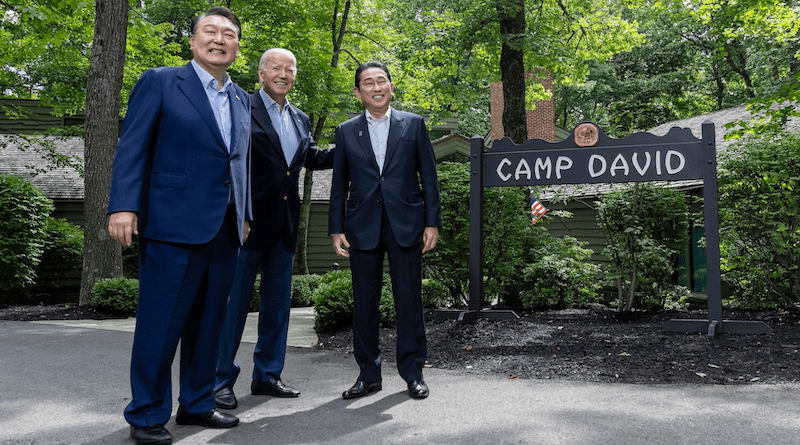A Closer Look At Fragmented Unity Of Asia-Pacific – OpEd
The Prime Minister of Japan and the President of the Republic of Korea were welcomed by the United States president at the first-ever trilateral summit at Camp David, where in a joint statement all three states condemned China and agreed to deepen military and economic cooperation. All states agreed to consult in terms of crises in response to regional challenges, provocations, and threats affecting common interests. The rise of China has seriously imbalanced the U.S. hegemony in the Asia-Pacific and the U.S., along with its allies is trying to encircle China.
The U.S. expectation in the Asia-Pacific is that all states should put aside their differences against each other to oppose a much larger contender. However, it is easier said than done as many states have outstanding issues against each other and these issues cannot certainly be ignored to oppose China in the region. From historical issues to territorial disputes, some of the most powerful allies of the U.S. in the region do not see eye to eye on certain regional issues.
Despite numerous endeavors to address the relationship between South Korea and Japan, a certain level of mistrust continues to exist, primarily arising from the annexation of Korea by Imperial Japan from 1910 until the culmination of the Second World War. Along with this, outstanding disputes still exist over volcanic islets, known as Dokdo in Korea and Takeshima in Japan, where both states claim to the islands. There have been multiple attempts by the U.S., and bilateral means, to mend ties, but the process has been on the slower side. Still, any misstep will take the bilateral ties back to square one, something which the U.S. cannot afford at this moment. However, there have been various normalization efforts as South Korean President Yoon Suk Yeol visited Japan in March of this year.
Similarly, due to concerns in the South China Sea, the Philippines have moved towards the U.S. in recent period in the administration of President Marcosas, compared to Former Philippines President Duterte, who aligned more with China and was confrontational towards the U.S. On the other hand, Vietnam although ideologically more in line with China due to the South China Sea dispute has moved towards the U.S. In fact, the U.S. calls Vietnam its “Leading Regional Partner” in the 2022 “Indo-Pacific Strategy”. However, both Philippines and Vietnam have disputes over the Spratly Islands claimed in their entirety by China, Vietnam, and Taiwan and portions of them are claimed by countries like the Philippines and Malaysia.
The recent events between China and the Philippines, where China used water canon in the disputed region of the South China Sea in an area of Second Thomas Shoal in the Spratly Islands, were criticized by Vietnam citing a violation of its sovereign right. This although not a major confrontation could potentially become a flashpoint of conflict between the Philippines, China, and Vietnam. In the past, clashes between Vietnam and the Philippines have emerged sometimes resulting in casualties.
This along with the lack of unity and limitations of ASEAN states has further complicated U.S.’s approach towards the region. As long as there are intra-state disputes within ASEAN, especially regarding the South China Sea, along with limitations in ASEAN, there is little ASEAN can do against Chinese claims. Divided ASEAN is beneficial for the Chinese leadership, it makes uniting against Chinese claims difficult.
The fragmented unity of Asia-Pacific would make it difficult for the U.S. to compete with Beijing. This also highlights the problem with the U.S. strategy in Asia-Pacific as the U.S. seeks hegemony in the region through security alliances and treaties but ignores the change in global order from unilateralism to multilateralism. This along with the policy of solely countering China, while ignoring military modernization and the economic rise of China could be the perfect recipe for disaster.
Certainly, it’s evident that China has significantly disrupted and challenged the U.S. presence in the region, and there are no indications of China intending to step back from this stance. Importantly, China’s aggressive position on the South China Sea might be in response to the United States’ assertive policy in the Asia-Pacific region, bolstered by its allies. The U.S. not only seeks to limit Chinese influence but also restrict access through the Pacific Ocean. Much like the United States concerns about open communication and sea access in Asia-Pacific, China could maintain similar anxiety due to its proximity to the region, in contrast to the more distant positioning of the U.S.
As of yet, states within the Asia-Pacific do not possess the capability to counter nor contain China even with U.S. backing. The intrastate problem, be it is historical or contemporary may also remain in the future, if bilateral problems are there to stay, so is China.

